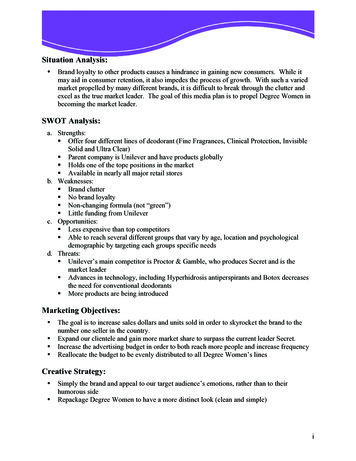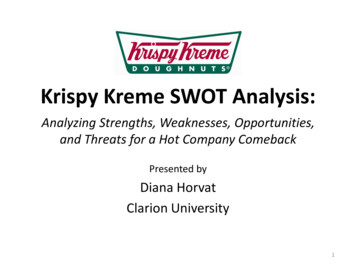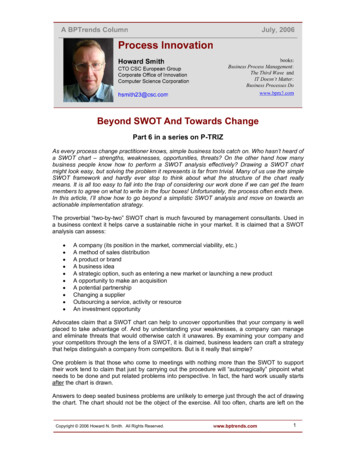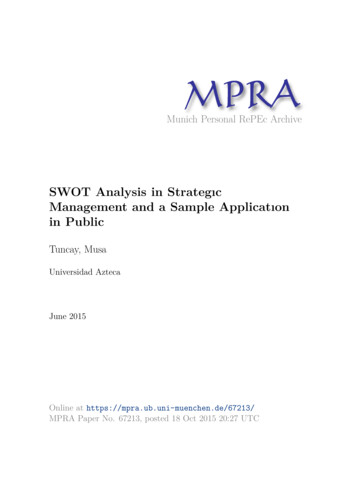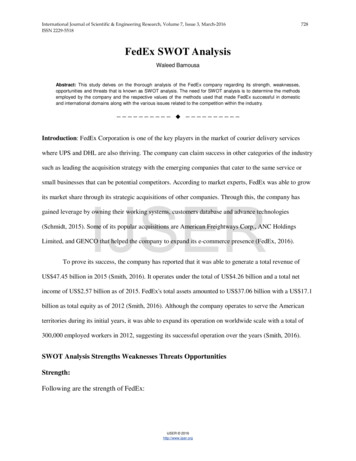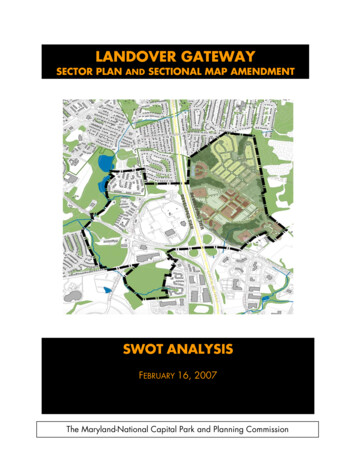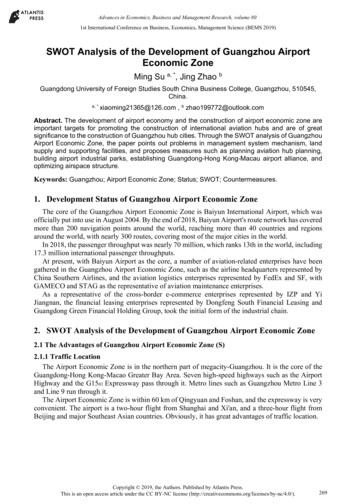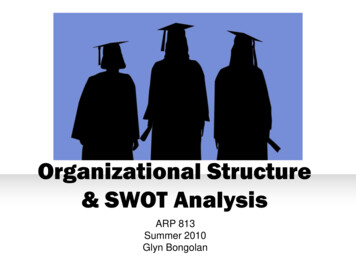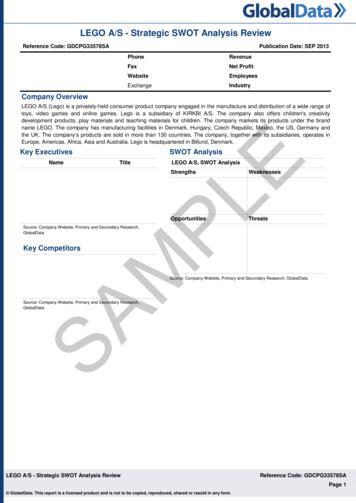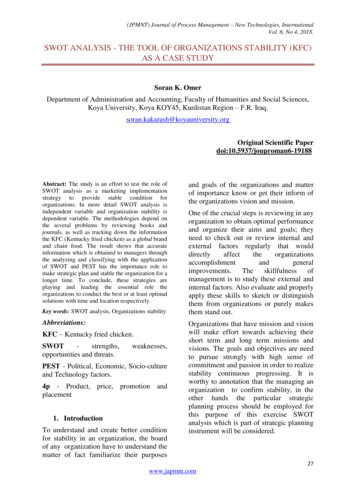
Transcription
Chapter 11The SWOT ANALYSIS: Processand Basic ComponentsPresented by: Kamelia Gulam1
Chapter Outline What is SWOT analysis? Basic Elements of The SWOT Analysis Aim of SWOT analysis. Who need SWOT analysis? SWOT Analysis for Individuals How to conduct SWOT analysis? Pitfalls of SWOT analysis. Tips for SWOT analysis.2
What is SWOT analysis A technique that enables organisations or individualto move from everyday problems and traditionalstrategies to a fresh prospective. SWOT analysis looks at your strengths andweaknesses, and the opportunities and threats yourbusiness faces. SWOT can help your company faceits greatest challenges and find its most promisingnew markets.3
The SWOT Analysis framework is a very importantand useful tool to use in marketing Managementand other business applications A clear understanding of SWOT is required forbusiness majors.4
Basic Elements of The SWOT Analysis5
Strengths (internal, positive factors) * Characteristics of the business or individual that give it anadvantage over others in the industry. * Positive tangible and intangible attributes, internal to anorganization or individual. * Beneficial aspects of the organization or the capabilities of anorganization, process capabilities, financial resources, productsand services, customer goodwill and brand loyalty. Examples - Abundant financial resources, Well-known brandname, Lower costs [raw materials or processes], Superiormanagement talent, Better marketing skills, Good distributionskills, Committed employees.6
Weaknesses (internal, negative factors) Characteristics that place the firm or individual at a disadvantagerelative to others. * Detract the organization from its ability to attain the core goaland influence its growth. * Weaknesses are the factors which do not meet the standardswe feel they should meet. However, weaknesses are controllable.They must be minimized and eliminated. Examples - Limited financial resources, Very narrow product line,Limited distribution, Higher costs, Weak market image, Poormarketing skills, Limited management skills, Under-trainedemployees.7
Opportunities Are external attractive factors that represent reasons your business is likelyto prosper. * Chances to make greater profits in the environment - External attractivefactors that represent the reason for an organization to exist & develop. * Arise when an organization can take benefit of conditions in itsenvironment to plan and execute strategies that enable it to become moreprofitable. * Organization should be careful and recognize the opportunities and graspthem whenever they arise. Examples - Rapid market growth, Rival firms are complacent, Changingcustomer needs/tastes, New uses for product discovered, Economic boom,Government deregulation, Sales decline for a substitute product .8
Threats (external, negative factors) * External elements in the environment that could causetrouble for the business - External factors, beyond anorganization’s control.! * Arise when conditions in external environment jeopardizethe reliability and profitability of the organization’s business. Examples - Entry of foreign competitors, Introduction of newsubstitute products, Product life cycle in decline, Changingcustomer needs/tastes, Rival firms adopt new strategies,Increased government regulation, Economic downturn.9
10
To help decision makersshare and compareideas. To bring a clearercommon purpose andunderstanding offactors for success.WS* To organize theimportant factors linked tosuccess and failure in thebusiness world.OT* To help individual ororganization tounderstand their strengthsand weaknesses. It promotes strategicthinking11
Who needs SWOT Analysis?2 When the team has not met its targets Customer service can be better Launching a new business unit topursue a new business New team leader is appointedBusiness UnitJob Holder1 When supervisor has issues withwork output Assigned to a new job New financial year – fresh targets Job holder seeks to improveperformance on the jobCompany3 Whenrevenue, cost & expensetargets are not being achieved Industry conditions are unfavorable Launching a new business venture12
Who needs SWOT Analysis?SWOT Analysis is also required for / during.Changing JobsProduct LaunchDecision MakingBrainstorm meetingsPersonal DevelopmentPlanningCompetitor EvaluationProblem solvingStrategic PlanningWorkshop SessionsProduct EvaluationPlanning13
SWOT Analysis for Individuals “Those with keen understanding of their strengths andneeds are in much better position than those with limitedor faulty self-knowledge.—Howard Gardner, Frames of Mind Personal SWOT analysis is a great tool to assessyourself in order to plan your career. You can use it to assess yourself, compare yourselfagainst your peers/competitors and also use it to findcareer growth opportunities.14
Personal SWOTCombination of Self-assessment tool Strategic planning activityAnd Created In light of an individual’s personal mission statement Their vision of where they see themselves in thefuture15
When to do a personal SWOT analysis ? When going to an interview – So you can focus on yourstrengths and talk about them more. It will help inpreparing the CV as well. If you have a very good ideaabout the job requirements beforehand you can modifythe CV to match them as well. When applying for a promotion – helps you to assessyourself against other candidates. You’ll have a goodunderstanding of your strengths against your competitorsso you can focus on them rather than your generalstrengths.16
Before a career switch – helps you to figureout whether your skills match theopportunities in your new career or whetherthey are much suited for your current job.17
How to conduct SWOT Analysis?1. Analyse Internal &External Environment2. Perform SWO TAnalysis3. Prepare Action Plans18
1. Analyse Internal & External Environment19
1. SO strategies—use a firm’s internalstrengths to take advantageof external opportunities.(LEVERAGE)2. WO strategies—are aimed atimproving internal weaknesses bytaking advantageof external opportunities.(CONSTRAINTS)3. ST strategies—use a firm’s strengthsto avoid or reduce the impactof external threats.(VULNERABILITIES)4. WT strategies—are defensive tacticsdirected at reducing internal weaknessesand avoiding external threats.(PROBLEMS)20
21
2. Perform SWOT Analysis & Document (1) Establish the objectives - Purpose of conducting aSWOT may be wide / narrow, general / specific. Select contributors - Expert opinion may be required forSWOT Allocate research & information gathering tasks Background preparation can be carried out in two stages– Exploratory and Detailed. Information on Strengths &Weaknesses should focus on the internal factors. Create a workshop environment - Encourage anatmosphere conducive to the free flow of information.22
2. Perform SWOT Analysis & Document (2) Evaluate listed ideas against Objectives - Withthe lists compiled, sort and group facts and ideas inrelation to the objectives. List Strengths, Weaknesses, Opportunities, &threats Carry your findings forward - Make sure that theSWOT analysis is used in subsequent planning.Revisit your findings at suitable time intervals.23
3. Prepare Action PlanOnce the SWOT analysis has been completed, markeach point with: Things that MUST be addressed immediately Things that can be handled now Things that should be researched further Things that should be planned for the future24
Advantages of SWOT (1) In social work practice framework is beneficial because ithelps organizations decide whether or not an objective isobtainable and therefore enables organizations to setachievable goals, objectives, and steps to further the socialchange or community development effort. In organisation it enables organizers to take visions andproduce practical and efficient outcomes in order to effectlong-lasting change, and it helps organizations gathermeaningful information in order to maximize their potential.25
Advantages of SWOT (2) In the individual to know yourself more by focusing andanswer objectively on each of the four questions, you willbe able to get a less emotional and more realisticanalysis. I know that the SWOT analysis Analyze lets youlook objectively at your role and your performance, tosee what you can change it to get the desired results.And also it allows you to take some action towardopportunities, and reduce your weaknesses.26
Limitations of SWOT SWOT can be misused as a technique, as it can be quicklydesigned without critical thought leading to a misrepresentationof SWOT, within an organization's internal and externalsurroundings. Development of a swot analysis simply to defend previouslydecided goals and objectives. Leads to: Limitations on brainstorming possibilities and "real" identificationof barriers. Also places the organization’s interest above the well being ofthe community. The design of a swot analysis by one or two community workersis limiting to the realities of the forces specifically externalfactors, and devalues the possible contributions of communitymembers.27
Tips of conducting SWOT analysisDO’SDON’T S Be analytical and specific.х Try to disguise weaknesses. Record all thoughts and ideas. Be selective in the final evaluation. Choose the right people for theexercise. Choose a suitable SWOT leader orfacilitator. Think out of the box Be open to changeх Merely list errors andmistakes.х Lose sight of externalinfluences and trends.х Allow the SWOT to becomea blame-laying exercise.х Ignore the outcomes at laterstages of the planning process.28
Tips & ExerciseEXAMPLEMc Donald’s SWOT Analysis29
Tips & ExerciseMc Donald’sSWOT AnalysisINTERNALSTRENGTHSWEAKNESSES Ranks very high on the Fortune Magazine's mostadmired list Community oriented Global operations all over the world Cultural diversity in the foods Excellent location Assembly line operations. Use of top quality products Failing pizza test market thus limiting theability to compete with pizza providers. High training costs due to high turnover. Minimal concentration on organic foods. Not much variation in seasonal products . Quality concerns due to franchised operations. Focus on burgers / fried foods not on healthieroptions for their customers.OPPORTUNITIESTHREATS Opening more joint ventures. Being more responsive to healthier options. Advertising wifi services in the branches. Expanding on the advertising on beingmore socially responsible Expansions of business into newly developedparts of the world. Open products up toallergen free optionssuch as peanut free. Marketing strategies that entice people fromsmall children to adults. Lawsuits for offering unhealthy foods. Contamination risks that include the threat ofe-coli containments. The vast amount of fast food restaurants thatare open as competition. Focus on healthier dieting by consumers. Down turn in economy affecting the ability to eatthat much.EXTERNAL30
Conclusion A SWOT analysis identifies your S, W, O and T toassist you in making strategic plans and decisions. SWOT is a simple yet comprehensive way ofassessing the positive and negative forces within andwithout your organization, so you can be betterprepared to act effectively31
32
Development of a swot analysis simply to defend previously decided goals and objectives. Leads to:- Limitations on brainstorming possibilities and "real" identification of barriers. Also places the organization’s interest above the well being of the community. The design of a swot analysis by one or two community workers is limiting to the realities of the forces specifically external .File Size: 1MBPage Count: 32
